Quirky, eccentric, eclectic and … oh so very English! Most cities and towns in the UK have allotments – strips of land which can be rented at a reasonable cost by interested gardeners. It is a fascinating microcosm, unlike anything else. A world of recycling and upcycling, low cost gardening, and ingenious solutions to knotty problems!

Although allotments have roots which stretch back to Anglo Saxon times, our present system was formed in the 19th century when land was given over to the poor so that they could grow their own food. From 1908 the ‘Small holdings and Allotment Act’ placed a duty on Local Authorities across the country to provide enough plots to meet demand. This was put into place more fully at the end of the First World War, when land was made available to returning servicemen. Further legislation has served to strengthen the rights of allotment holders, ensuring that land cannot be sold off easily.
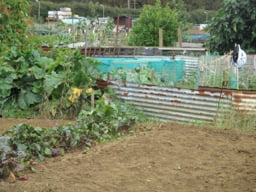 Allotments have grown in popularity over the last few years, so that there is often a long waiting list for prospective gardeners. Once they are allocated their patch of land, they have to sign an agreement to ensure, for example, that they do not neglect it, put pigs on it, or erect any permanent buildings.
Allotments have grown in popularity over the last few years, so that there is often a long waiting list for prospective gardeners. Once they are allocated their patch of land, they have to sign an agreement to ensure, for example, that they do not neglect it, put pigs on it, or erect any permanent buildings.
A tenancy agreement from 1846 stated that:
“Every occupier is expected to attend divine service on Sundays; and any occupier who digs potatoes or otherwise works on his land on Sunday shall immediately forfeit the same.”
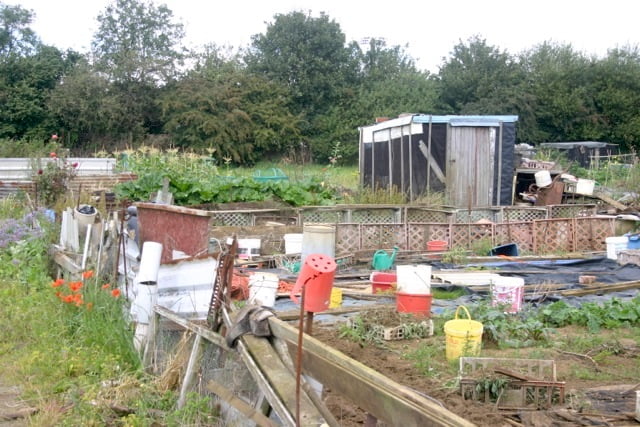
Thankfully, things have changed since then!
It is what people do with their strips of land which is so fascinating! There exists a unique culture of creativity, ensuring that allotment sites are always interesting places for a little wander. The over-arching ethos is to construct whatever you need, out of whatever you can find. Need somewhere to sit ? Use an old car seat ! Need a cold frame ? Make one out of old window frames and bricks! Although permanent structures are often not permitted, there is nothing to stop gardeners fashioning a shed for themselves out of old windows and doors, perhaps, or a greenhouse out of clear plastic bottles. Allotment holders are endlessly ingenious about the way they use – and reuse – materials.
Back in the day, allotment holders were perceived as male, craggy and ancient! Their sheds were bastions of testosterone and women were rarely to be seen. Things have certainly changed today, as men and women of all ages, and cultures, are keen to get involved.
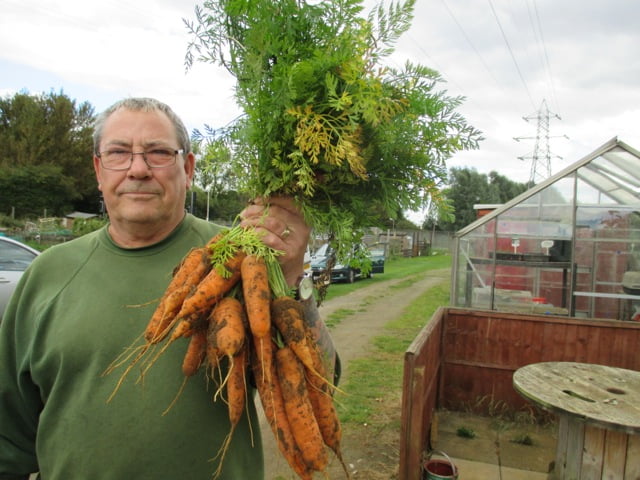
One thing which has not changed with the passing of the years, is the sense of community which most allotments foster. More experienced members are usually happy to advise newcomers and will give, or swap, their produce and seed. Many allotment societies have annual shows where members can exhibit their successes, and vie with each other in friendly rivalry.
Great characters are still to be found tending their plots, and they have a wealth of knowledge to share. I visited my local allotments recently and found some very friendly people waiting to greet me! Literally waiting! They told me that they maintain a benign watch over the whole site, which helps to stop vandalism and theft, as strangers are spotted immediately. I discovered that these allotment holders felt a huge pride in their own plots and those of others, and were keen to show them off.
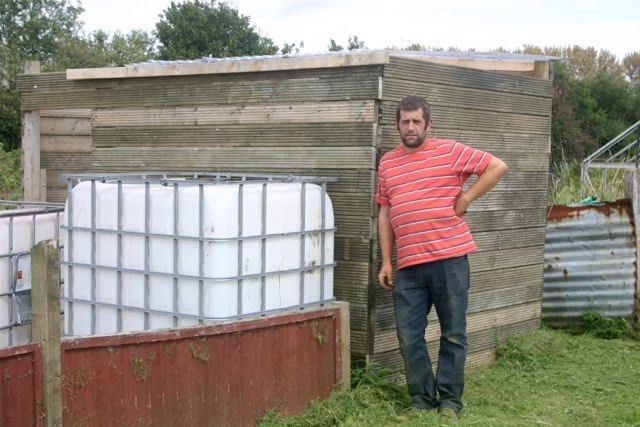
Colin, pictured here, constructed his new shed entirely with old decking, which he had taken up in his own garden, and had no further use for. Other materials were given by friends and so the whole project cost him virtually nothing.
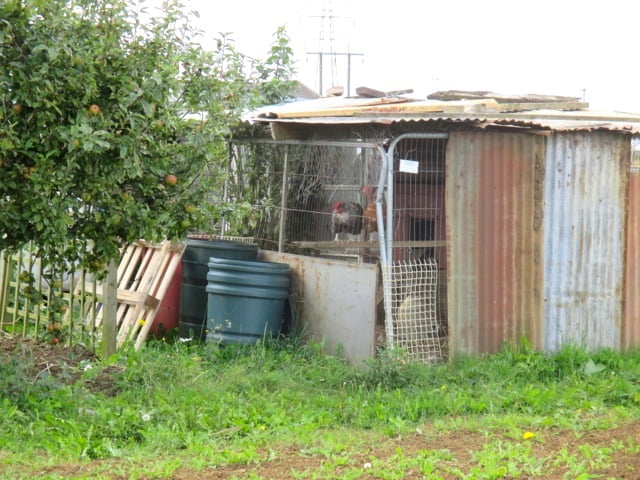
Some of the Allotment holders were keen poultry keepers, and the regulations of the site allowed them to keep six chickens. Some of the runs were constructed from random pieces of netting and wire, but inside the henhouses the birds were clean and cosy.
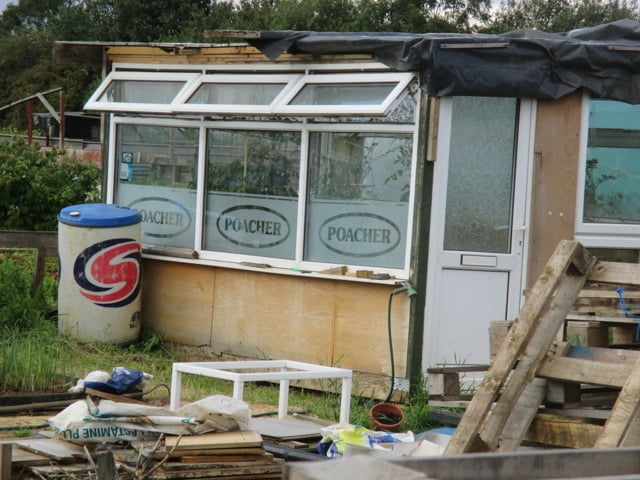
This greenhouse was constructed at very low cost, as all the components had been discarded as waste. The windows, etched with the word ‘Poacher’, were saved from a pub of the same name, which was being demolished.
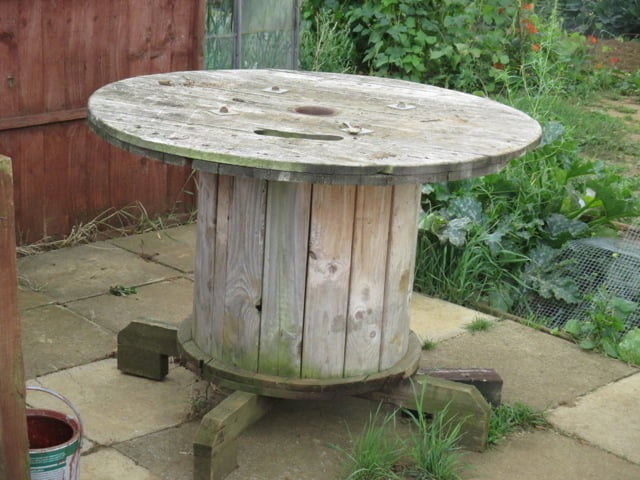
On one of the allotments was this ingenious table, constructed from a large cable drum which had probably been used, initially, at the nearby steel works. Legs had been fashioned for it, and it was sited on a small paved area, next to a greenhouse, perfect for al fresco meals!
A large variety of vegetables were flourishing on the plots, but perhaps more surprising, were the fruit trees and soft fruit bushes grown there. Allotment holders were taking a chance with these, as they may have to be left behind if the plot is given up for any reason. There were apple, pear and plum trees as well as raspberry canes, gooseberries, strawberries, red currants, black currants and blackberries. Most plots had a lot of space given over to potatoes, from first earlies to mains, which have cropped well this season, so I was informed. Many gardeners had some way of growing under glass, (however it was fashioned) and tomatoes were the main crop of choice, although peppers, aubergines and chillies were grown too.
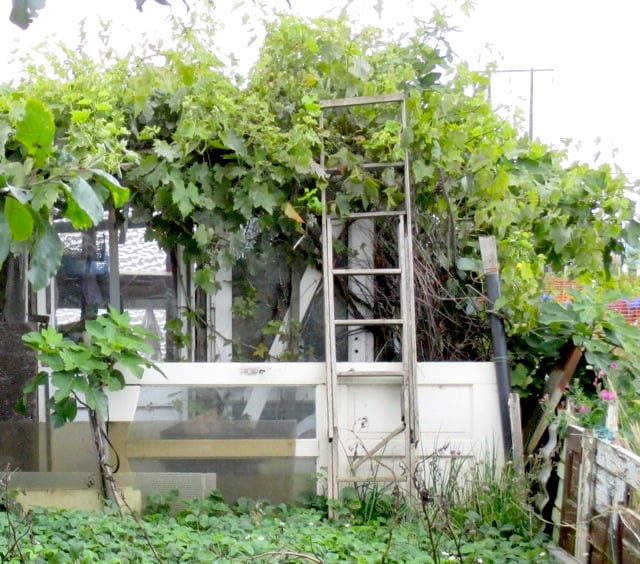
Pictured is a huge grape vine engulfing a tiny shed, complete with ladder for harvesting!
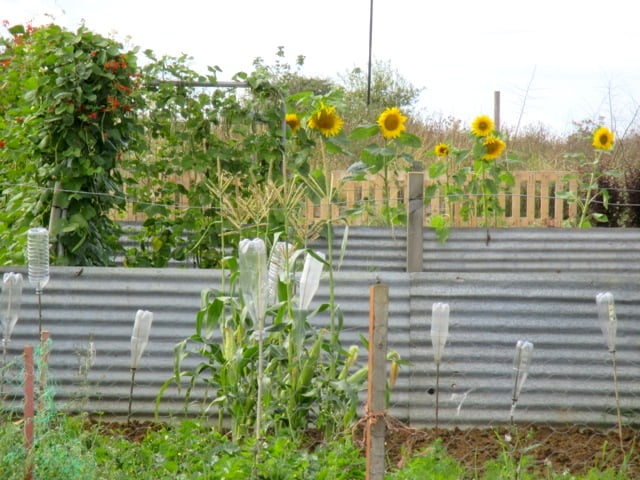
On Kozito’s plot was a block of well grown sweet corn, but he was concerned that it would not ripen in the cool, late summer weather. It was his first season on the allotment, and he was slowly winning his battle with the weeds.
Note the upturned bottles on canes to scare away the birds. Some gardeners use beer cans for the same purpose – empty of course!
The Council rotovates allotments when someone takes over a plot which has been neglected, but after that initial help, it is the responsibility of the gardener to keep it well maintained. Many sites have systems in place which ultimately remove allotments from holders who do not look after them, usually after a number of warnings have been given.
There are lively, supportive communities awaiting new allotment holders across the country, where they can grow fruit and veg organically and cheaply, with expert advice, should it be needed. They can also rest assured that any ingenious growing solution will be welcomed wholeheartedly by other plot holders!
[For more of Jane’s insightful commentary and gardening experiences, visit her blog at Hoe Hoe Grow]
